How to Make a Subway Map with John Tauranac
Hear from an author and map designer who has been creating maps of the NYC subway, officially and unofficially, for over forty years!


When you think of Woodside, the first things that probably come to mind are food and diversity. Located in the western part of Queens and bordered to the south by Maspeth, the north by Astoria, the west by Sunnyside, and the east by Elmhurst and Jackson Heights, Woodside is among the most diverse areas in Queens. Both a residential and commercial neighborhood, it consists of bustling avenues filled with small businesses right alongside peaceful streets with big houses. Sometimes, it’s hard to believe that these two worlds co-exist as one in Woodside.
Once part of Newtown in the 1800s, drastic residential development in the 1860s led Woodside to become the biggest Irish-American community in Queens, and it continues to maintain a prominent Irish population today. However, in recent decades, Asian American and Latino families have moved into the area so that today, Woodside is home to many diverse populations.
Thus, the average New Yorker probably knows Woodside as a cultural hub lined with diverse businesses and the ethnic enclave Little Manila. While all this is true and something that Woodside is proud of, there is much more to the neighborhood, especially when you consider the history behind some of its buildings. In fact, once you finish reading this guide, you’ll also know Woodside as a place with a former Loew’s theater, remnants of Child’s Restaurants and a trolley barn, and much more of the unexpected. Read on to rediscover Woodside with these 16-must-visit places.

It might come as a surprise to Woodside residents and church-goers that St. Sebastian’s Church was once a Loew’s Theatre! The Loew’s Woodside theater opened on September 27, 1926, and was designed by Herbert J. Krapp. The theater’s huge capacity—over 2,000 people—is still reflected in the vastness of the church’s interior today. The theater’s opening night featured a pre-release of Buster Keaton’s comedy film, the Battling Butler.
In the 1950s, the theater was sold to the to the St. Sebastian Roman Catholic parish, which outgrew its original chapel. Slowly but surely, the entrance and lobby of the theater were demolished, replaced with a Romanesque bell tower. However, the theater’s auditorium decor was kept intact, including the domed ceiling and 40 columns along the side walls.
Maintaining the theater’s interior beauty, today, St. Sebastian’s serves a diverse array of parishioners, providing Spanish masses and the occasional Tagalog and Korean mass.
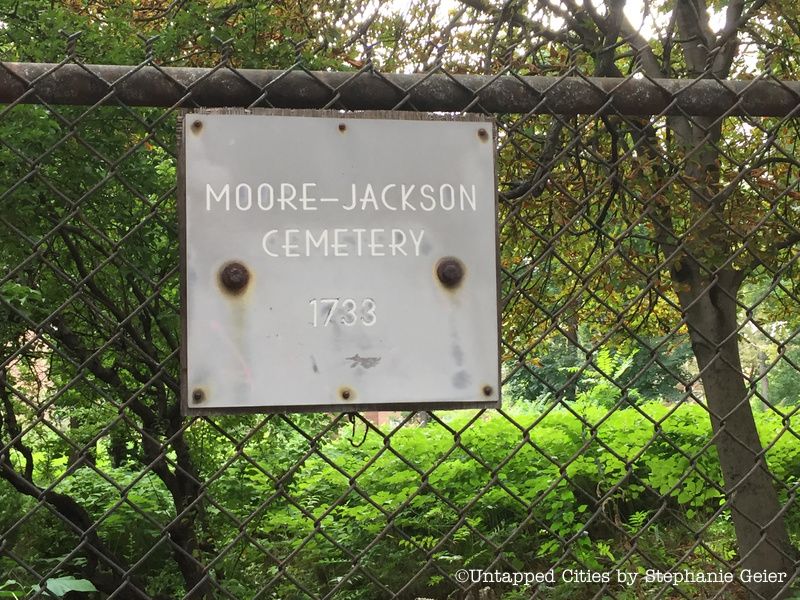
Right off the bat, one of the most unexpected places in Woodside is the surviving colonial burial ground, the Moore Jackson Cemetery. Discreetly hidden at at 31-30 to 31-36 54th Street, this cemetery is one of New York City’s oldest and smallest, with just 15 remaining headstones. Some of the surnames on the headstones include Moore, Jackson, Fish, Rapelye, Hallet, Mecke, and Berrian. The most well-preserved of the tombstones is that of Augustine Moore, who died in 1769.

The burial ground was created in 1733 on the farmland of Samuel Moore, the son of Newtown’s first minister, as part of 100 acres that included a farmhouse. After a man named John Jackson married into the family, the burial ground became the “Moore-Jackson” cemetery.
In the 1820s, the land was sold except for the cemetery, with the cemetery’s last internment occurring in the late 1860s. Over the years it fell into decay, overgrown with weeds and falling victim to vandalism. It wasn’t until the 1970s that real restoration efforts emerged and local residents began to pay more attention to the cemetery’s well-being. It was finally declared a landmark in 1997 and is currently owned by the Queens Historical Society.
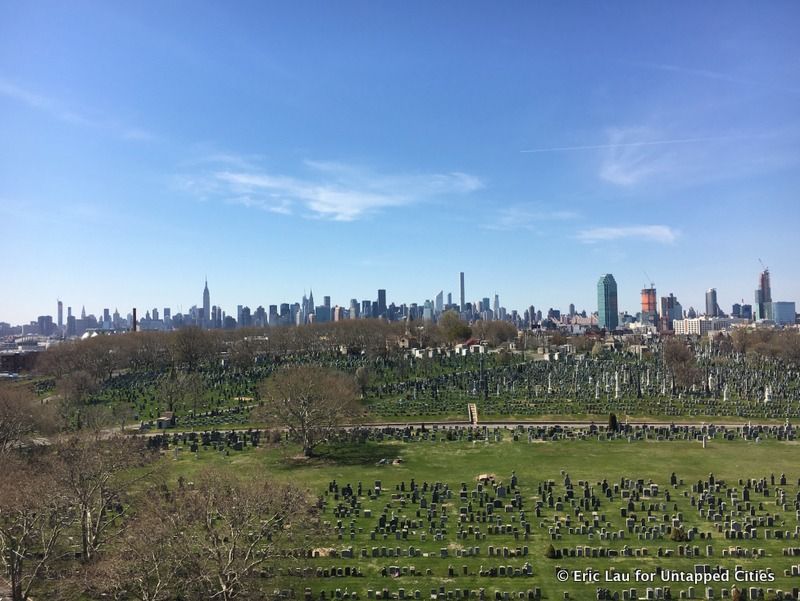
Since you now know about one of New York City’s smallest cemeteries in Woodside, head over to the largest cemetery in the country (by number of internments). Spanning both Woodside and Maspeth, the vast Roman Catholic Calvary Cemetery is 365 acres. The site of about 3 million burials, it is not only the largest, but also one of the oldest cemeteries in the country. Calvary Cemetery is owned by the Roman Catholic Archdiocese of New York and managed by the Trustees of St. Patrick’s Cathedral.
The cemetery is divided into four sections: First Calvary Cemetery between the Long Island Expressway and Review Avenue; Second Calvary Cemetery on the west side of 58th Street between Queens Boulevard and the Brooklyn–Queens Expressway; Third Calvary Cemetery on the west side of 58th Street between the Long Island Expressway and the Brooklyn–Queens Expressway; and Fourth Calvary Cemetery on the west side of 58th Street between the Long Island Expressway and 55th Avenue.
The history of Calvary Cemetery began in 1817, when the Trustees of Old St. Patrick’s Cathedral found that their Mulberry Street Cemetery was reaching capacity. In 1847, mired by the cholera epidemic and burial ground shortage in Manhattan, the state passed the Rural Cemetery Act allowing nonprofit corporations to operate commercial cemeteries. The cathedral then used land they purchased in Maspeth to create Calvary Cemetery, which was consecrated by the Archbishop in 1848.
As burials rose, the Archdiocese expanded the cemetery’s acreage, transforming it into the vast area it is today. It is now home to the Calvary Veterans Park, which contains the Calvary Monument honoring the 69th Regiment. It is one of many public parks to serve as a burial ground, although it is the only New York City park completely surrounded by a cemetery. This park, along with the cemetery’s vast tranquility and many notable figures buried inside, make it worth visiting.
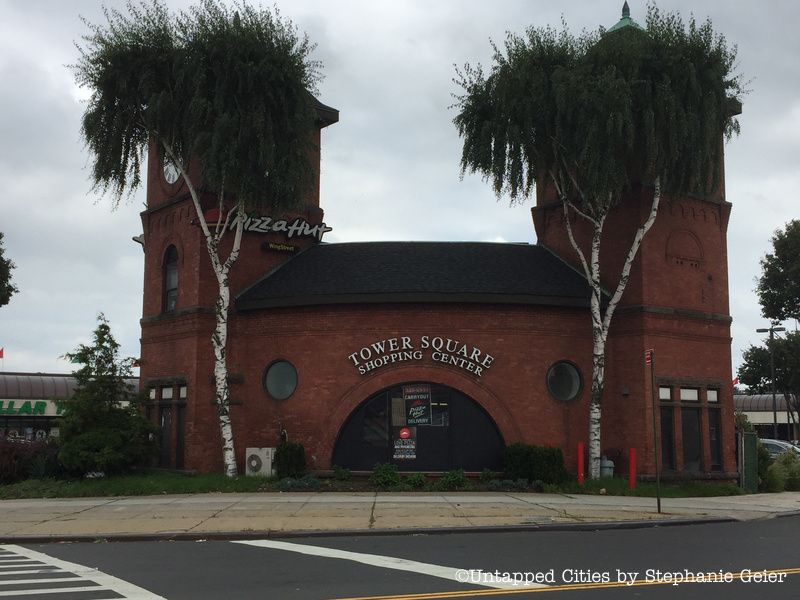
How many people can say they ate pizza in a former trolley barn? Well now, you can, if you head over to the Tower Square Shopping Center. While it now looks like your typical shopping center, home to a Starbucks, Pizza Hut, Michael’s Art Supplies, and more, the shopping center was actually a 19th century trolley terminal! You can still see evidence of this former transportation hub from the inscription remaining on its facade, subtly reading “NY AND QUEENS CO., RYI CO” and “WAITING ROOM.”
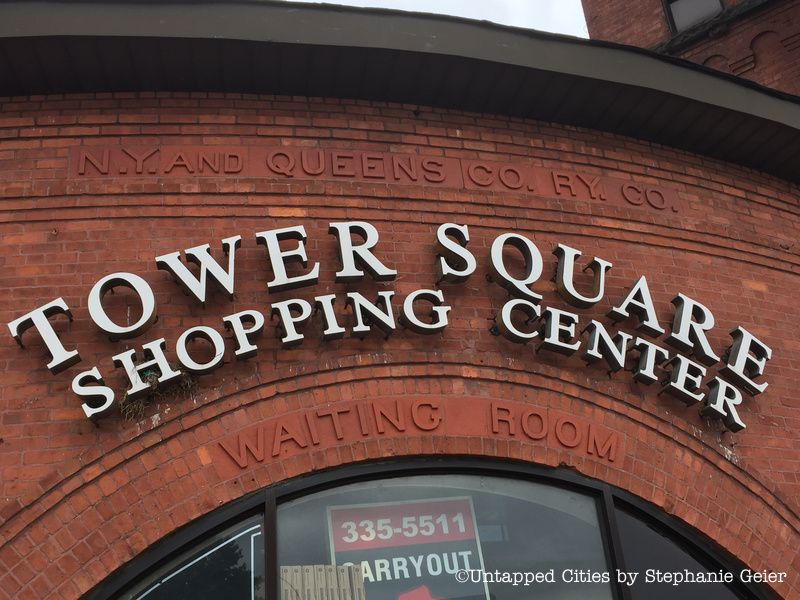
The trolley barn was built in 1896 for the New York and Queens Railroad Company, which was established that year when the Steinway Railway Company and Newtown Railroad Company sold out to investors from Philadelphia who wanted to build a trolley line in Queens. During its existence, the building served trolley cars from Flushing, College Point, Jamaica, and Long Island City, and was the site of the largest carbarn in Queens.
With the formation of the Independent Subway System and the advent of motorized buses, trolley companies like the New York and Queens Railroad Company came to an end. The building serviced the last trolley in about 1937.
In the 1980s, there were plans to tear the building down, but they came to a somewhat dramatic halt when a stop-work order was issued minutes after a bulldozer began working on the clocktower in 1987. The last-minute success in saving the building was the result of persistent efforts by community preservationists, who had gathered around the building while it was about to be bulldozed. Thanks to them, eating and shopping at the Tower Square Shopping Center has a lot more meaning than your regular shopping experience.

Amidst all the diverse businesses lining Roosevelt Avenue, this bicycle shop will catch your eye with its faded yellow and blue vintage sign. As the sign proudly displays, Bill’s Cyclery was established in 1939, and has remained intact since then. If you’re a bike rider, head over here stat! They sell a variety of bikes of different brands, including Dahon, SF Racing, Fuji, and GT. You can also choose from a wide selection of helmets, pumps, and water bottles. Need something fixed? Bill’s also does services and repairs for your bike.
If you’re not sure what you need, there are buyers’ guides on their website, or the staff at the store will be happy to help you out.
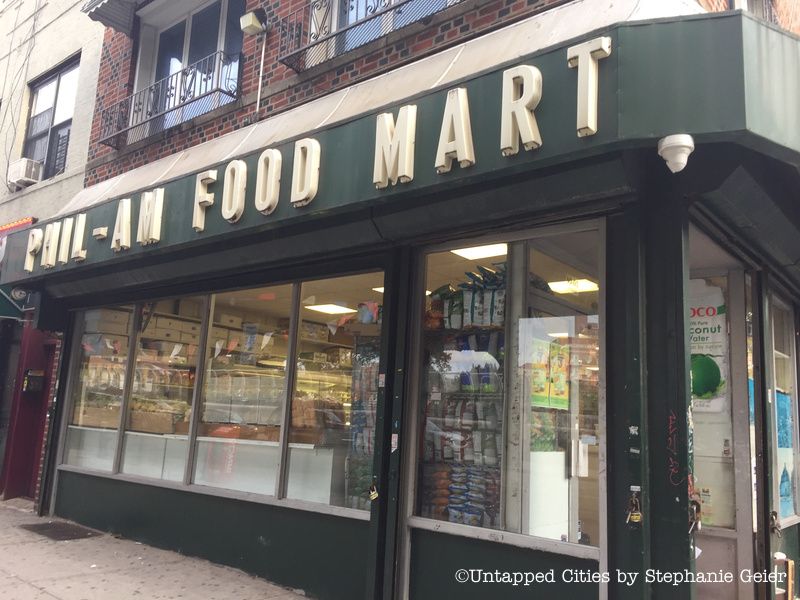
While you’re in Woodside, you might as well seize the chance and buy some Filipino groceries. The Phil-Am Food Market is small but packed with snacks and ingredients you’ll need. It’s a little on the pricey side, but considering that Filipino grocery stores are hard to come by, it’s worth it. Whether you want to try your hand at cooking a Filipino dish or just want to take some sweets or snacks back home with you, Phil-Am foods is where you need to be. Always filled with people from the surrounding Filipino community, and Filipinos outside of it who want food that reminds them of home, Phil-Am foods is the go-to for an authentic taste of the Philippines.
Some of their must-buy items include quarts of ube and mango ice cream, pan de sal (slightly sweet bread that makes a great breakfast), ensaymada (sticky bread with cheese and stuffed with ube or coconut), and snacks like pork rinds and mango sunflower crackers. They also sell produce, as well as fresh meat and seafood in the back, along with special seasoning and other basic Filipino ingredients you’ll need.
If you plan to visit, note that Phil-Am Foods is closed on Wednesdays.
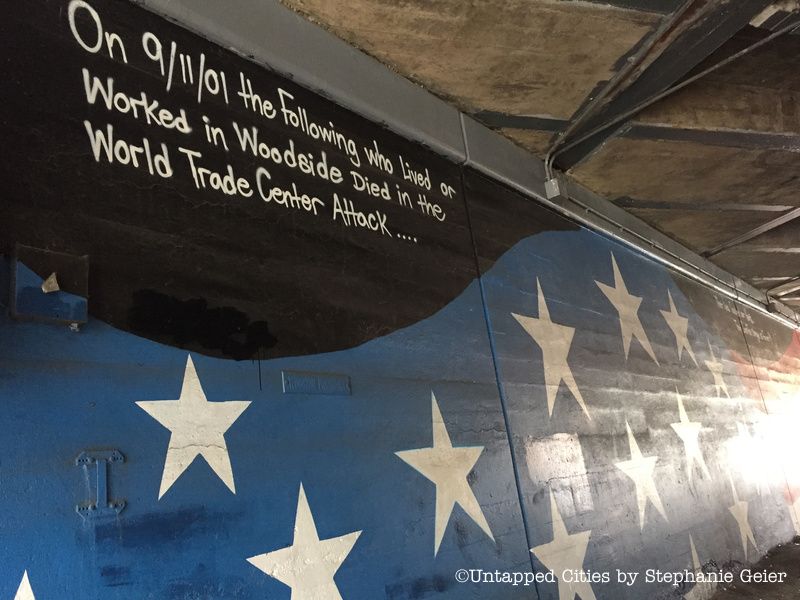
You won’t find any big museums or exhibits in Woodside, but you will find the occasional vibrant mural. The major one to check out is the 9/11 mural commissioned by Woodside on the Move, a grassroots organization dedicated to “making Woodside and Western Queens a better place to live and learn.” Spanning the wall on 61st street under the subway station on Roosevelt Avenue, it was painted in 2011 to commemorate the 10th anniversary of 9/11 and our fallen heroes, families, and friends.
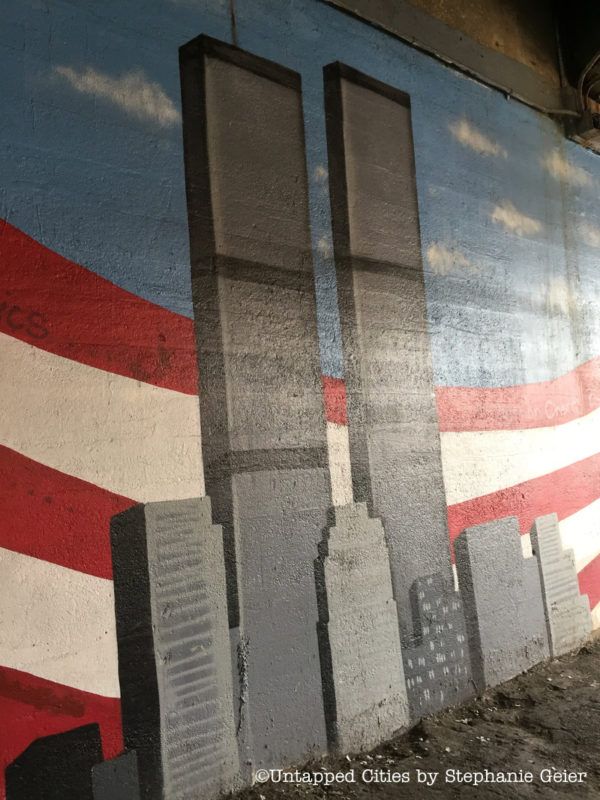
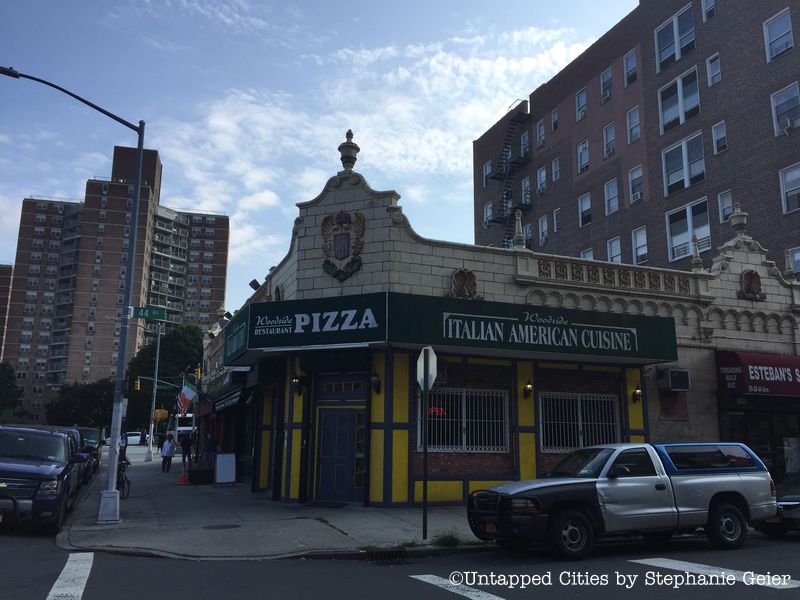
Child’s Restaurants, one of the first national dining chains in the country, once had over 125 locations when it peaked in the 1920s-30s—and it appears that two of them are right here in Woodside! Former Child’s Restaurants are scattered around the city, and you can still see some of their remains if you know where to look (and know to look up!)
The first former Child’s Building at 59-37 Queens Boulevard at 60th Street was built in 1931, according to Forgotten New York, when the designers started implementing more advanced decor. The building, now housing several everyday businesses, has a nondescript appearance. But this changes when you look up and see the terra cotta decor that was signature of Child’s Restaurants back then, including iconic sea horses, urns, and a coat of arms.

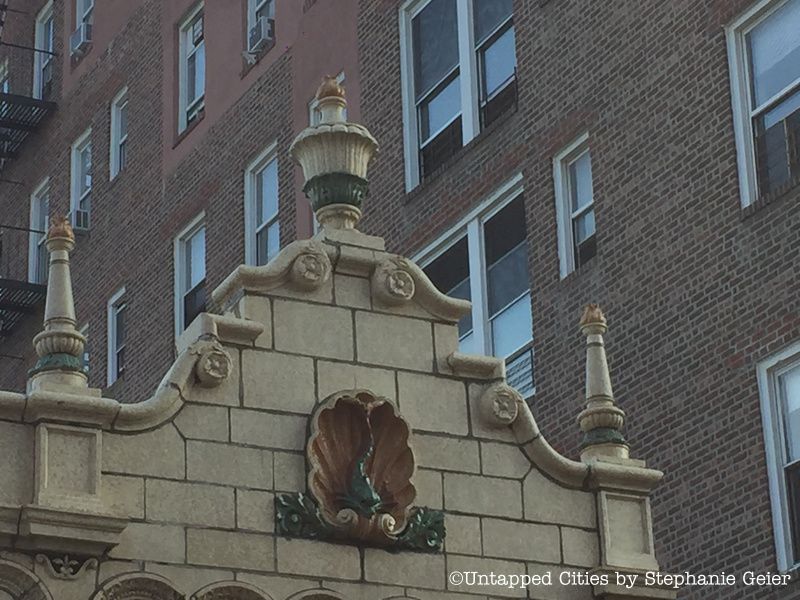
Woodside’s second former Child’s Restaurant is at 63-09 Roosevelt Avenue, now home to a supermarket, T-Mobile store, and other businesses. It was built in 1925, according to Forgotten NY. Sitting on the corner of one of Woodside’s busiest streets, most people walking by don’t think twice about this building. But history and architecture buffs will definitely pause and recognize its nautical-themed decor and knowingly appreciate the spontaneity it adds to Woodside.
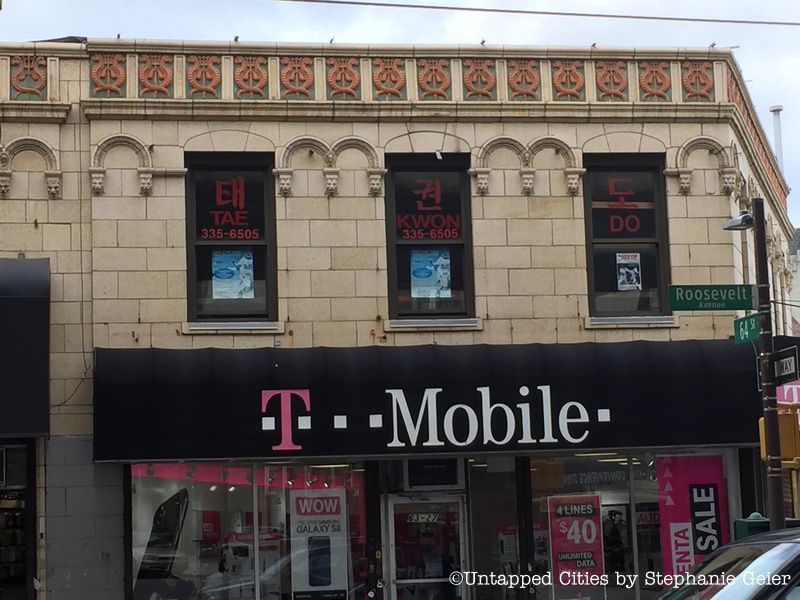

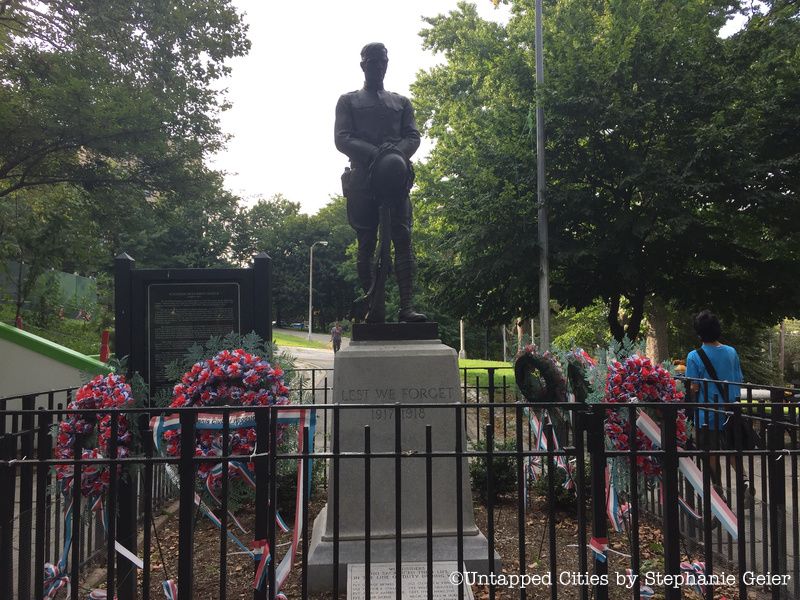
While there aren’t any major parks in Woodside, Doughboy Park is a small gem, both for its simplicity and history. This 1.71 acre park and plaza, bounded by Woodside Avenue, 52nd Street, and 39th Road, is notable for its statue of a doughboy and small garden honoring our fallen heroes.
In 1893, the space was used as a play area for the adjacent P.S. 11 school. In 1898, the park passed into the City’s ownership, when Newtown and other municipalities in Queens merged with New York City. But the land was determined to be too steep and overgrown for children to play on, and was assigned to NYC Parks in 1957. The land was accordingly developed into a sitting space for adults, which is today more suitable for a place that is home to such a dignified monument. Finally, in 1971, the park received its name by local law.
The park’s center attraction and namesake, the doughboy monument, has been there since 1923 in honor of “doughboys,” or the nickname for members of the U.S. Army or Marine Corps prominently used by the British during World War I (because the big round buttons on American uniforms resembled British cakes known as “doughboys.”) The sculpture was created by Burt W. Johnson from Flushing, and the resulting reverently solemn WWI soldier holding his helmet and gun continues to stand tall on a granite pedestal inscribed with “LEST WE FORGET 1917-1918.”

Even before the statue went up, soldiers from Woodside would gather here at the “mustering ground” before leaving to fight. Sadly, ten soldiers who left from the park never returned, In remembrance of these soldiers and others who died, the Woodside Community Council erected the statue. It was dedicated on Memorial Day in 1923, in a ceremony attended by many local residents, and in 1928, the American Federation of Arts selected the Woodside Doughboy as the best war memorial of its kind.
In 1990, the statue was renewed with cleaning, repatinating, and coated with wax, and the surrounding plaza was renovated in 2001 to include benches, so you can now sit down and appreciate the history and meaning of the doughboy statue. A stone panel has also been installed with the names of eleven major First World War campaigns and seven key battles in which American soldiers fought.
The park itself now has a small dog run (currently under construction), multiple benches, and a hilly lawn to sprawl or play on. Keeping up with tradition that started in the 1920s, locals continue to gather in the plaza on Memorial Day.

Ah yes, the part you’ve all been waiting for and the main reason most people come to Woodside: restaurants. It was hard to narrow down the eateries, but here’s one you should definitely visit.
Rated the number one Thai spot in NYC by Zagat from 2006 – 2007, and in top 30 in New York City in Zagat food category, it’s no surprise that SriPraPhai is a must-visit place in Woodside. It is known for Thai cuisine both bold and authentic, along with its idyllic garden where you can sit outside if the weather is nice.
The story behind the restaurant, which has another location in Williston Park, New York, is just as incredible as its food.
Founder Sripraphai Tipmanee first came to New York 33 years ago as a nurse, according to their website. However, she soon “desired to be her own boss,” starting an electrical appliance store, but was eventually forced to sell it. Recognizing the area’s large Thai population, Tipmanee started a bakery and Thai dessert center, which gradually became a restaurant as she realized that it would be more successful as one. She moved her business to its current location, expanding and adding a garden that makes it so sought-after.
The menu includes has an overwhelmingly large and diverse array of options that is sure to satisfy anyone’s taste buds, from more familiar dishes like spicy BBQ, fried sausage, Pad Thai, and literally dozens of noodle soups, to more unconventional options like Northern Style Curry Noodles and Crispy Ground Catfish.
It’s hard not to get overwhelmed by their menu—there are literally 45 appetizers, 23 noodle items, and 42 a la carte items. So come prepared, with people, or ask the waiters what their specialties are if you need help deciding. (Thankfully, their dessert menu is a lot smaller, though still equally delicious). Aside from their mouthwatering menu, their quaint courtyard alone is reason enough to come here!
If you plan to visit the Woodside location, bring cash, as it is cash-only.

You simply can’t visit Woodside without trying out Filipino cuisine. Woodside, is. after all, home to the Filipino ethnic enclave “Little Manila.” The Filipino fast-food chain Jollibee may seem tempting with its big crowds always taking pictures with the chain’s iconic bee statue outside. But if you want more variety and food that is freshly prepared and authentic, go for Krystal’s Cafe and Pastry Shop. Trust us, you won’t be disappointed, especially if this is your introduction to Filipino cuisine.
Krystal’s is known for their low-cost, upstairs lunch buffet that offers many options, both savory and sweet. They also have a lively karaoke scene at night in their upstairs seating area.
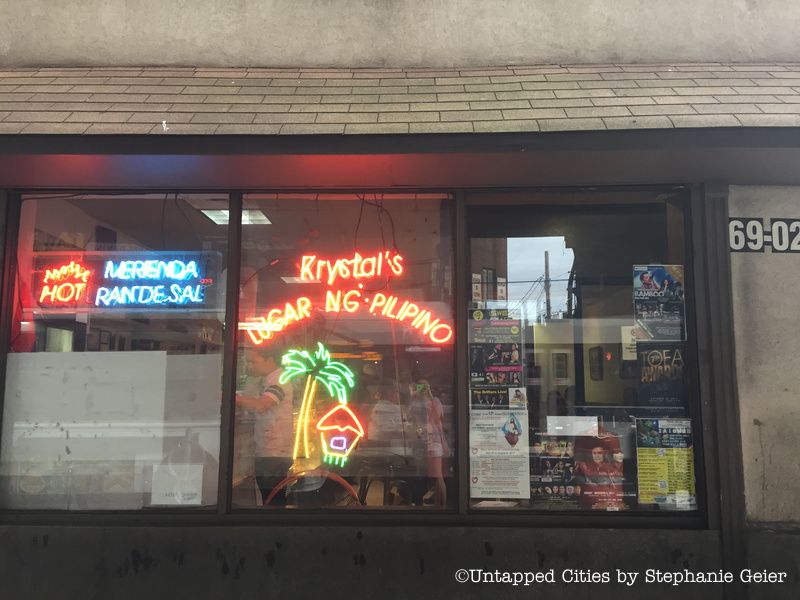
Breakfast, dinner, or even just dessert are worth coming here for. They serve an array of must-have Filipino dishes, with a bakery for dessert afterwards, in addition to a dessert menu. Their famous dishes include kare-kare (oxtail with savory peanut butter sauce), lumpia (spring rolls with meat fillings), adobo chicken (seasoned chicken), Pancit Bihon (noodles with shrimp, chicken, and vegetables), and lechon kawali (broiled and deep fried pork belly).
Make sure you get dessert after; have a slice of ube (purple yam) cake, the mouthwatering sans rival (think layers of buttercream, meringue, and cashews), cassava cake (sticky cassava topped with coconut and condensed milk), or of course, the famous Halo-Halo, shaved ice with evaporated milk and packed with ingredients like red beans, jello, coconut, fruit, and topped with flan or ube ice cream (you’ll want to Instagram this one).
Here are other Filipino restaurants in Woodside that deserve special shoutouts: Tito Rad’s, Payag, House of Inasal, Ihawan, Papa’s Kitchen, and of course, Jollibee.

Trimble Road
Trimble Road, the block from 62nd to 63rd Streets along the Long Island Rail Road north of Woodside Avenue, and Hicks Drive, the block from 63rd and 64th Streets running south of the LIRR tracks, have interesting stories. In 1915, when Woodside was undergoing big changes due to factors like transportation, some streets faced disruption. Forgotten NY explains that as Woodside became urbanized, the LIRR was streamlining its operations, building a “wide right of way” for most of its branches all the way to Jamaica and removing grade crossings to prepare for the “open cut on which tracks would be built.”

Trimble Road
Short streets were built along the tracks to allow cars and horse carts to pass. Trimble Avenue which used to be 10th street, was thus sharply bent to Hicks Avenue, formerly 11th street. It wasn’t until the 1920s that they were renamed to 62nd and 63rd streets, but the sharp bends along the railroads retained their old names and stand out among the numbered streets of Woodside.
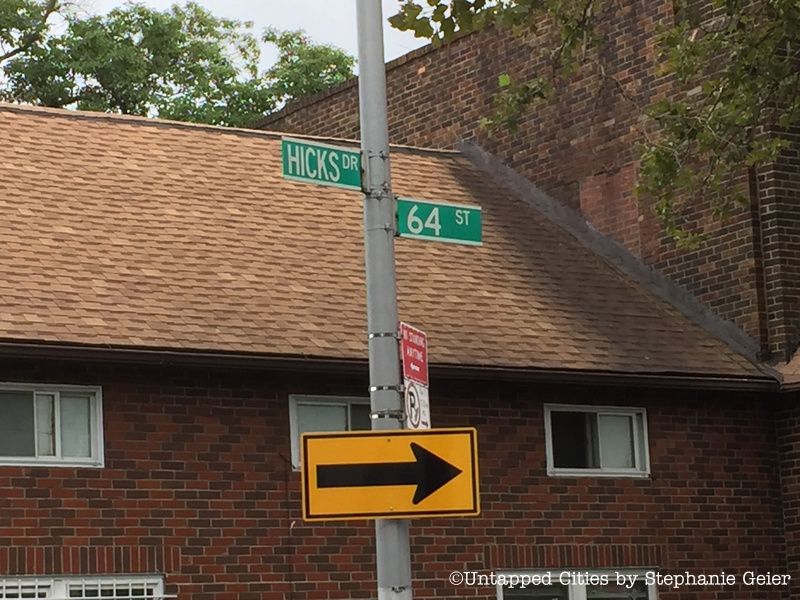
Hicks DriveHicks Drive
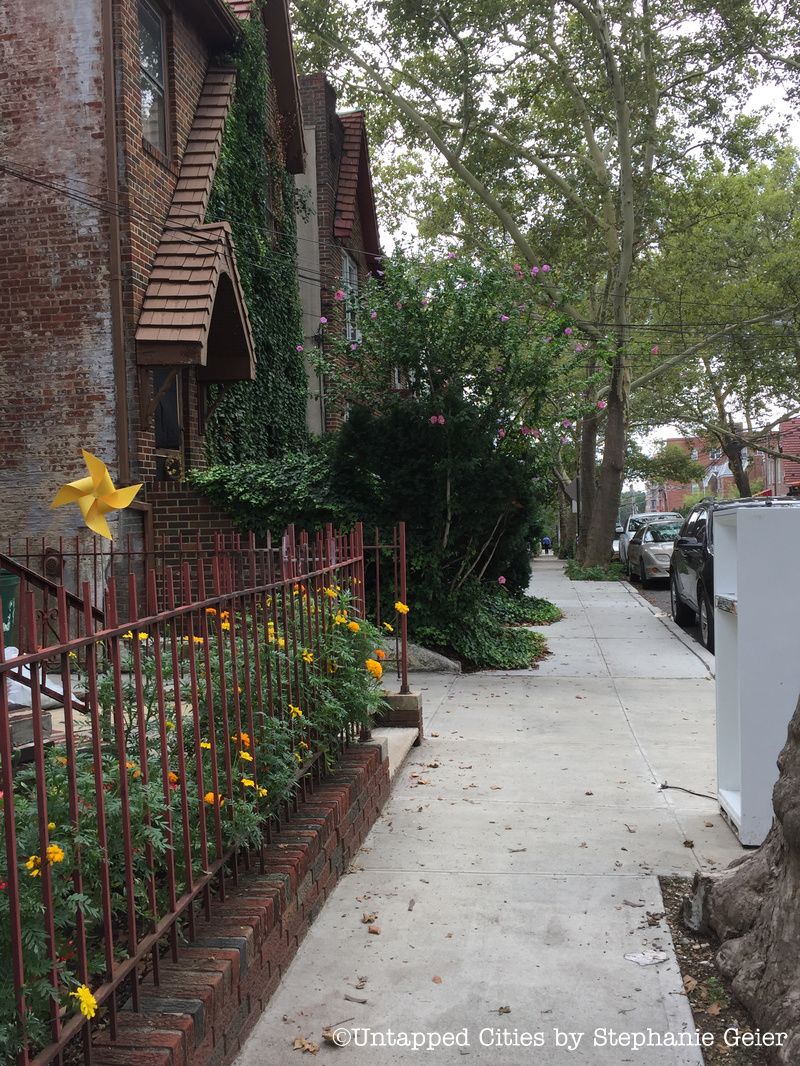
Hicks Drive
Besides this interesting historical tidbit, Trimble Road and Hicks Drive are must- visits because of their silent, quaint nature providing unexpected relief from the busyness of Roosevelt Avenue and the LIRR area. When you walk down these narrow blocks, you’ll see large cozy homes, small backyard gardens, and hear the occasional train mysteriously whir by through overgrown greenery along the fence.
Hicks Drive and Trimble Road truly capture another face of Woodside that you need to see and feel in order to get to know the area.
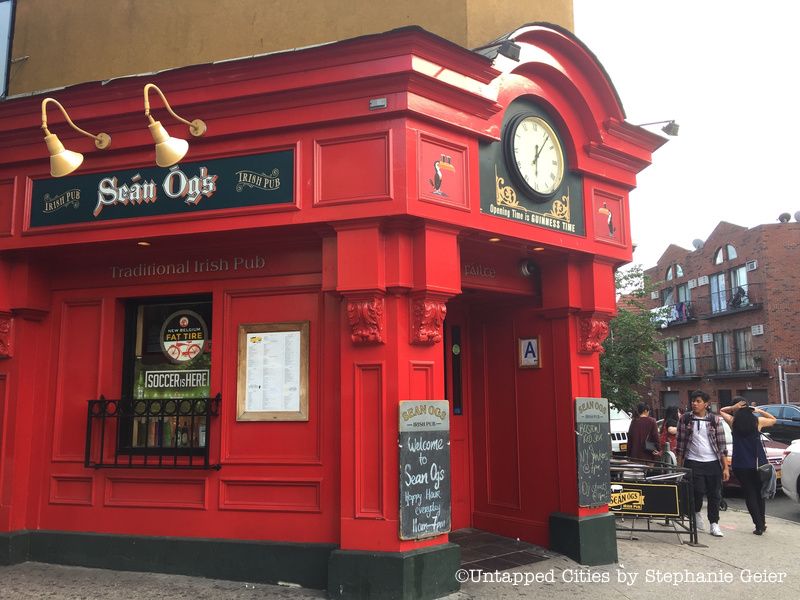
Woodside locals flock to Sean Og Tavern for a good time. This vivid, red Irish pub stands out on the corner of Woodside Avenue and 62nd street, with its old-style clock and gothic-style lettering. Its inside is dark and gothic as its exterior suggests, adorned with a cathedral ceiling, exposed beams, and sleek chairs. Despite its dark appearance, Sean Og’s is known for its personable, welcoming bartenders and energetic nightlife, with New York Magazine describing it as “a good place to make some bad drunken memories.”
You can choose from a large selection of low-priced beers and savory bar food, and if you need to escape the dark interior, there’s outdoor seating for you. But you’ll probably find yourself wanting to go back inside at some point, as there’s a small dance floor, TVs, and overall friendly, high-key vibes that will leave you with a great night.

Another pub that pays tribute to Woodside’s Irish population, Donovan’s Pub, is another must-visit in Woodside. Priding itself as “Woodside’s Landmark Gathering Place since 1966,” Donovan’s Pub is the place to go if you crave a full, scrumptious meal with your drink or have kids with you. It has a brunch menu for $14.95 (add $5 for unlimited mimosas or Bloody Marys), with children’s brunch for just $8.95. It offers traditional Irish options, including sirloin steak, Irish Bacon, Irish Sausage, and Black and White Pudding.
There’s also a lunch and dinner menu with options like Toasted Garlic Bread with mozzarella cheese, Donovan’s Wings, Shepherd’s Pie, and several kinds of burgers and meat-heavy entrees.
For drinks, there are several kinds of beers on tap, from your regular Guinness to Goose Island, as well as an array of bottled beers. They also have appealing frozen drinks, like the Mudslide (Ice Cream, Baileys, Kaluha & Snmirnoff Vodka) and Jamaican Punch (Pina Colada, Myers Rum, Orange Juice & a splash of grenadine). Donovan’s pub has it all, and as shown by its 51-year existence and loyalty of Woodside locals who keep coming back, it’s well-worth the visit.
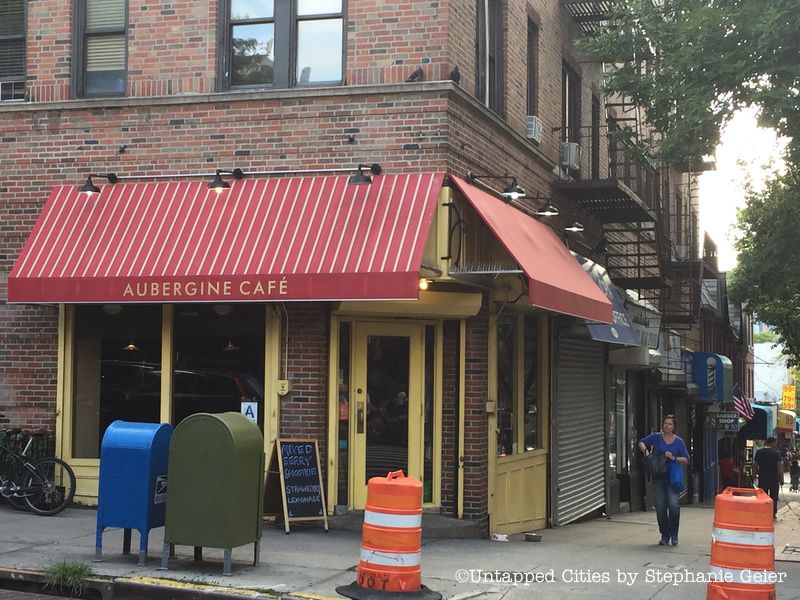
If you need a break from Woodside’s busiest areas, head over the Aubergine Cafe on Skillman Avenue. Located in a residential area and far enough away from the hub of Woodside underneath the 7 train line, Aubergine is an upscale coffee shop with pastries, sandwiches, beer and wine, and of course, your regular caffeine fixes.
Opened in 2003, Aubergine has brought speciality coffee and quality delicacies to not just Woodside, but perhaps more frequently, residents of the nearby Sunnyside, along with those from Jackson Heights, Astoria, and Long Island City. Their beans are hand selected at Irving Farm, and they work with New York City’s best bakeries to create their breads, desserts, and even breakfast bars.
Their breakfast menu includes everything from avocado toast to Irish oatmeal and chia seed pudding. For lunch or dinner, you can get items like homemade chili and a smoked salmon platter salad.
Despite its restaurant-y nature, many locals come here to sip coffee and read or work on their laptops. Aubergine’s coffee menu includes your regular coffee and espresso options, as well as chai spiced lattes, green tea lattes, iced mochaninos, and most temptingly, the Ghiradhelli Chocolate/Mocha Frappe.
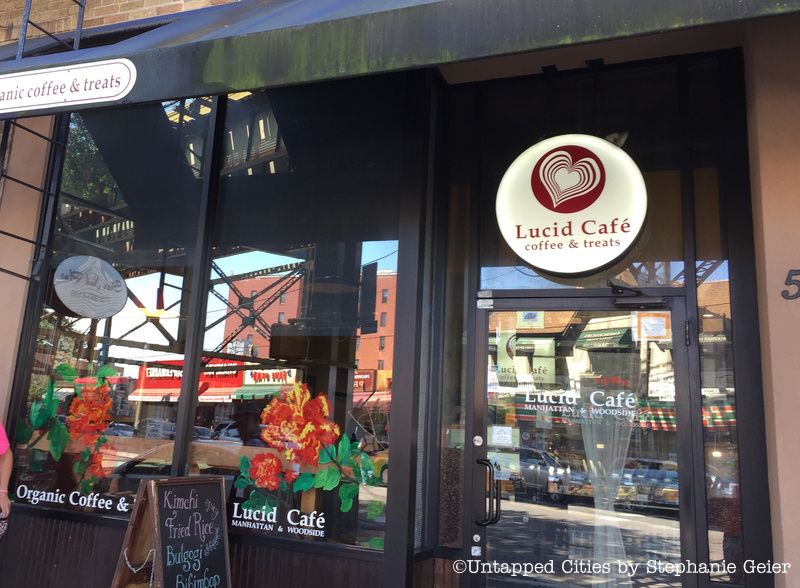
If you’re used to working and studying in quiet coffee shops, you’ll breathe a sigh of relief when you see the Lucid Cafe. The busiest areas of Woodside lack places for people to work and study, which is why Lucid Cafe was much-needed and serves a key purpose for Woodside locals. With its cozy interior and wifi, Lucid Cafe is Woodside’s go-to if you need to focus or get that caffeine fix, with well-brewed coffee, a range of espresso drinks, and fresh pastries. People who are more inclined to tea should try their Honey Lemon Ginger Tea or Peach Black or Tropical Green Iced Tea. Or if you’re hungry for more than a pastry, the Lucid Cafe also has meals, including French Toast, ricotta cheese salad, kimchi fried rice, and bulgogi bibimbap. As its name suggests, the Lucid Cafe, which has another location in Manhattan, will definitely brighten your mood after a drink, pastry, and a few cozy minutes inside.
Next, check out our Untapped guides of the neighborhoods of Astoria and Inwood.
Subscribe to our newsletter